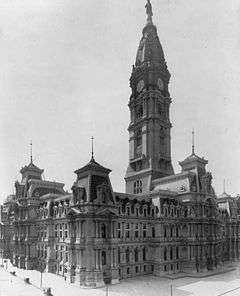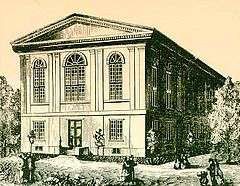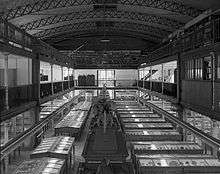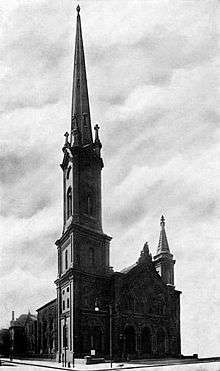John McArthur, Jr.

John McArthur Jr (1823–1890) was a prominent American architect based in Philadelphia. Best remembered as the architect of the landmark Philadelphia City Hall, McArthur also designed some of the city's most ambitious buildings of the Civil War era. Few of his buildings survive.

Career
John McArthur, Jr., was born in Bladenock, Scotland, on 13 May 1823,[1] and came to the United States with his family when he was ten years old. Much of his mature style was characterized by Italianate and Second Empire forms and several of his best-known buildings feature mansard roofs, which he helped to introduce and popularize in the United States. During the American Civil War, McArthur planned 24 temporary war hospitals, including Fort Delaware's 600-bed hospital on Pea Patch Island.[2]
Philadelphia has looked up to McArthur’s architecture for more than a century. The 250-foot-tall tower-and-spire of his Tenth Presbyterian Church (1854) was the tallest structure in the city when built. (Its 150-foot wooden spire was removed in 1912.) Later, this was surpassed by the tower of City Hall (1874–1901), whose 548 feet (167 meters) made it the tallest occupied building in the world when completed. Until the late 20th century, an unwritten agreement among Philadelphia architects kept all buildings shorter than the top of the statue of William Penn atop McArthur’s tower.
A Presbyterian and a member of Tenth Church, McArthur was married to Matilda Prevost; they had two sons and two daughters.
McArthur died in Philadelphia on January 8, 1890.
Architectural work
This is a partial list.




Philadelphia buildings
- Tenth Presbyterian Church, 17th & Spruce Sts., Philadelphia (1854, altered by Frank Miles Day 1893)[3]
- Wagner Free Institute of Science, 1700 W. Montgomery Ave., Philadelphia (1859–65)
- First National Bank Building, 315 Chestnut Street, Philadelphia (1865–67). Now a museum run by the Chemical Heritage Foundation.
- Philadelphia City Hall, Penn Square, Philadelphia (1874–1901) (with Thomas U. Walter)
Demolished Philadelphia buildings
- Assembly Building, 10th & Chestnut Sts. Philadelphia (1851, rebuilt 1852 possibly by McArthur, demolished)
- Girard House Hotel, n. side of Chestnut St. at 9th St., Philadelphia (1852, demolished)
- La Pierre House, South Broad St., Philadelphia (1856, demolished)
- Continental Hotel, SE corner 9th & Chestnut Sts., Philadelphia (1857–1860, demolished)[4]
- American Sunday School Union building, 316-320 Chestnut St., Philadelphia (1858, demolished)
- Franklin Farmers' Market, 100 block of Market St., Philadelphia (1859, demolished)
- Mikveh Israel Synagogue, 117 N. 7th St., Philadelphia (1860, demolished)[5]
- Mower Hospital (temporary Civil War hospital), Wyndmoor, Philadelphia (1863, demolished)
- Residence for Dr. David Jayne, 19th & Chestnut Sts., Philadelphia (1865, demolished)
- Public Ledger Building, SW corner 6th & Chestnut Sts., Philadelphia (1867, demolished)
- John McArthur, Jr. Residence, 4203 Walnut St., Philadelphia (1881, demolished).
- Children’s Ward, Presbyterian Hospital, 39th & Filbert Sts., Philadelphia (1881–88, demolished).
- Entrance, The Woodlands, Philadelphia (1936, demolished)[6]
Buildings elsewhere
- First Presbyterian Church, Capitol Square, 10th & Capitol Sts., Richmond, Virginia (1852-3)[7]
- U.S. Naval Hospital, Mare Island, California (1853)[8][9]
- U.S. Army Hospital, Fort Delaware, Pea Patch Island, Delaware. (1863, demolished)
- State Hospital for the Insane, Danville, Pennsylvania (1869). Still in use as Danville State Hospital.[10]
- Pardee Hall, Lafayette College, Easton, Pennsylvania (1873).[11][12]
- Hospital for the Insane, Warren, Pennsylvania (1874) (a Kirkbride Plan building). Still in use as Warren State Hospital.[13]
Gallery
 La Pierre House, 100 block of South Broad St., Philadelphia (1856, demolished)
La Pierre House, 100 block of South Broad St., Philadelphia (1856, demolished)%2C_by_Bartlett_%26_French.jpg) Continental Hotel, SE corner 9th & Chestnut Sts., Philadelphia (1857-1860, demolished).
Continental Hotel, SE corner 9th & Chestnut Sts., Philadelphia (1857-1860, demolished). Franklin Farmers' Market, 100 block Market St., Philadelphia (1859, demolished).
Franklin Farmers' Market, 100 block Market St., Philadelphia (1859, demolished). Wagner Free Institute of Science (1859–65), second-floor Hall and galleries.
Wagner Free Institute of Science (1859–65), second-floor Hall and galleries. Mikveh Israel Synagogue, 117 N. 17th St., Philadelphia (1860, demolished).
Mikveh Israel Synagogue, 117 N. 17th St., Philadelphia (1860, demolished). U.S. Hospital, Fort Delaware, Pea Patch Island, DE (1863, demolished).
U.S. Hospital, Fort Delaware, Pea Patch Island, DE (1863, demolished). First National Bank, 315 Chestnut St., Philadelphia (1865–67). Now Chemical Heritage Foundation.
First National Bank, 315 Chestnut St., Philadelphia (1865–67). Now Chemical Heritage Foundation. Public Ledger Building, SW corner 6th & Chestnut Sts., Philadelphia (1867, demolished).
Public Ledger Building, SW corner 6th & Chestnut Sts., Philadelphia (1867, demolished). Congress Hall and Public Ledger Building.
Congress Hall and Public Ledger Building..jpg) Public Ledger Building from Independence Hall tower.
Public Ledger Building from Independence Hall tower. Pardee Hall, Lafayette College, Easton, PA (1873).
Pardee Hall, Lafayette College, Easton, PA (1873). Philadelphia City Hall cornerstone. Laid July 4, 1874.
Philadelphia City Hall cornerstone. Laid July 4, 1874. Philadelphia City Hall Tower under construction, 1890s?
Philadelphia City Hall Tower under construction, 1890s? Children's Ward, Presbyterian Hospital, Philadelphia (1881–88, demolished).
Children's Ward, Presbyterian Hospital, Philadelphia (1881–88, demolished). Tenth Presbyterian Church, Philadelphia (1854)
Tenth Presbyterian Church, Philadelphia (1854)
Descendants
A descendant, David Paul McArthur, works as an architect out of the Fishtown section of Philadelphia.
References
- ↑ . JSTOR 988539. Missing or empty
|title=(help) - ↑ The Annual Report of the Library Company of Philadelphia, by Library Company of Philadelphia, page 52
- ↑ Our History & Architecture | Tenth Presbyterian Church
- ↑ Untitled Document
- ↑ Congregation Mikveh Israel
- ↑ "Woodlands Cemetery. Main Entrance". The Library Company of Philadelphia. World Digital Library. Retrieved 3 January 2014.
- ↑ http://www.vahistorical.org/lva/firstpres.htm
- ↑ Message from the President of the United States to the Two Houses of Congress, Millard Fillmore, 1853, p 738
- ↑ Mare Island is a National Register historic district #75002103, and also a National Historic Landmark.
- ↑ Danville State Hospital
- ↑ http://ww2.lafayette.edu/~library/special/survey/pardee.html
- ↑ Source: The Architect’s and Builders Pocket-Book, by Frank Eugene Kidder, 1908, page 1546
- ↑ Warren State Hospital * Asylum Architecture, History, Preservation * Kirkbride Buildings